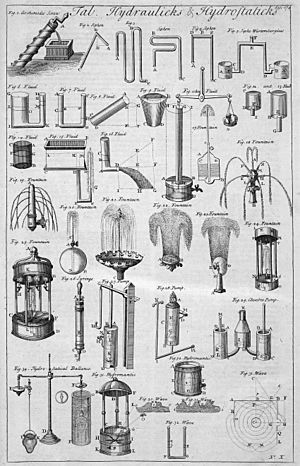Hydraulics facts for kids
Hydraulics is a part of science and engineering that studies how liquids behave and move. It looks at how liquids can be used to create power and make machines work. Think about how water flows in a river or how a digger's arm moves using oil – that's hydraulics in action!
Contents
What is Hydraulics?
Hydraulics is all about understanding the mechanical properties of liquids. This means studying how liquids like water or oil can push, pull, and lift heavy things. It's a very old field, but it's still super important today.
How Liquids Create Power
The main idea behind hydraulics is that liquids can't be easily squashed. If you push on a liquid in a closed space, that push (or pressure) is sent equally in all directions. This is called Pascal's principle. This principle allows a small force applied to a liquid to create a much larger force somewhere else.
Pascal's Principle Explained
Imagine a tube filled with water. If you push on one end with a small plunger, the water pushes on a larger plunger at the other end with much more force. This is how hydraulic systems multiply force. It's like magic, but it's just science!
History of Hydraulics
People have used hydraulic ideas for thousands of years. Ancient civilizations built amazing aqueducts to carry water and used water wheels for grinding grain.
Early Pioneers
One of the important thinkers in modern hydraulics was Benedetto Castelli. He was a student of the famous scientist Galileo Galilei. Castelli helped us understand more about how water flows and moves.
How Hydraulics Works Today
Today, hydraulics is used in countless ways. It's the power behind many machines we see every day.
Everyday Uses of Hydraulics
- Car Brakes: When you push the brake pedal in a car, you're using a hydraulic system. A small push on the pedal creates a strong force that stops the car's wheels.
- Construction Machines: Big machines like excavators, bulldozers, and cranes use hydraulics. The powerful arms and buckets move because of hydraulic fluid pushing pistons.
- Aircraft: Airplanes use hydraulic systems for their landing gear, wing flaps, and steering. This helps them take off, fly, and land safely.
- Dams and Power Plants: Hydroelectric power plants use the force of flowing water to spin turbines and create electricity. This is a huge example of hydraulics on a large scale.
- Water Wheels: Historically, water wheels used the flow of rivers to power mills and factories. Some are still used today!
Fluid Mechanics and Hydraulics
Fluid mechanics is the bigger science that studies all fluids, including liquids and gases. Hydraulics focuses specifically on the practical, engineering uses of liquids. It takes the theories from fluid mechanics and applies them to build useful machines and systems.
Images for kids
-
Aqueduct of Segovia, a Roman masterpiece that carried water.
See also
In Spanish: Hidráulica para niños






